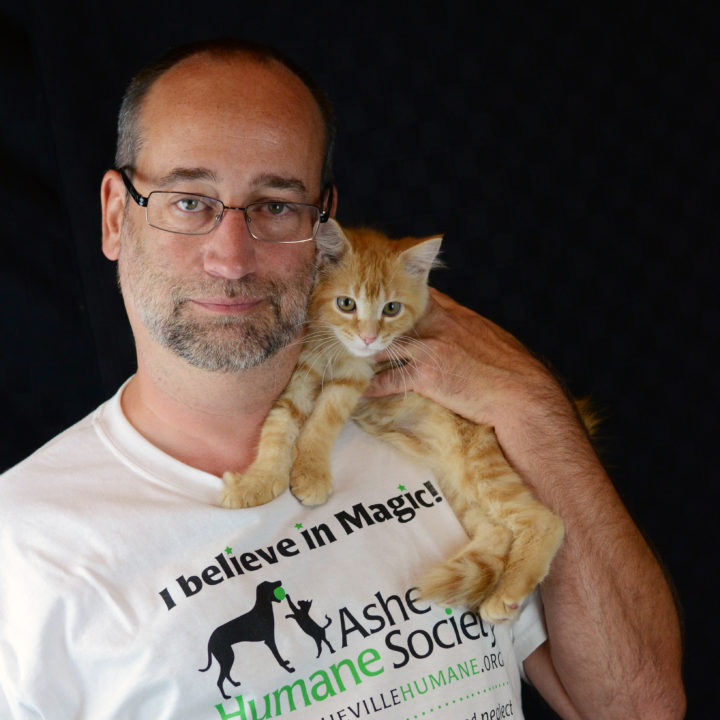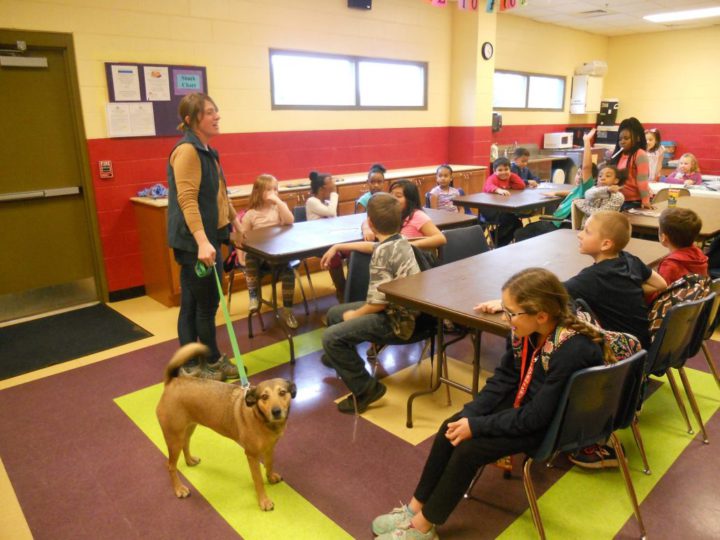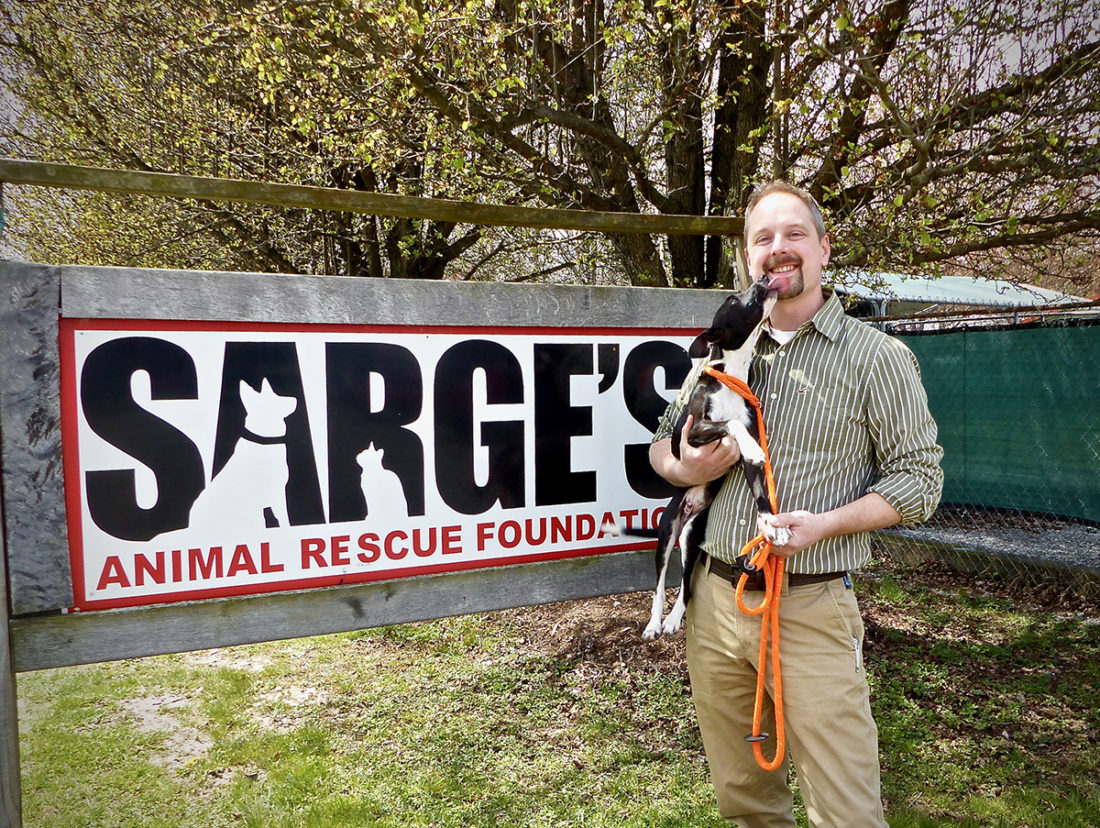Cartoons can reveal a great deal about Americans’ changing attitudes toward animals, says Angela Prodrick, executive director of the Blue Ridge Humane Society. In the 1955 Walt Disney animated feature film Lady and the Tramp, for example, the stray dogs’ greatest fear is being taken to the pound. And for good reason, Prodrick explains: At the time, it amounted to a death sentence.
In the modern-day cartoon series Family Guy, on the other hand, Brian Griffin, a white Labrador retriever who writes novels, is prone to “lounging on the couch and drinking martinis,” Prodrick says with a laugh.
Over the last half-century or so, she notes, the nation’s relationship with our furry, four-legged friends has gradually shifted — particularly the way we deal with homeless dogs and cats. In the 1970s, an estimated 13.5 million unwanted or unclaimed animals were euthanized each year, according to a September 2019 New York Times story. Back then, says Prodrick, “All the shelters were next to landfills,” to facilitate disposal of the carcasses that accumulated daily.
By the 1980s, communities across the country had launched spay-and-neuter campaigns, seeking to reduce the staggering number of homeless cats and dogs. That momentum carried into the ’90s, by which time no-kill shelters and more organized adoption programs had also begun springing up.
Yet as the new millennium began, the death rate remained high. Nationally, “More than 8 million dogs and cats a year end up in shelters,” the Asheville Citizen-Times reported on July 22, 2001. About half of those animals, the article noted, were euthanized.
More recently, however, those numbers have declined sharply. In 2017, American shelters euthanized some 2 million dogs and cats, according to the Best Friends Animal Society. The Utah-based national nonprofit operates the country’s largest animal sanctuary. And by last year, the organization’s website notes, the national death toll had dropped below the 1 million mark — to an estimated 733,000 — for the first time on record.
Here in Western North Carolina, a number of animal rescue groups and county-funded shelters are committed to keeping the local numbers down. At the same time, staffers at those organizations lament the fact that many members of the public mistakenly believe it’s possible to avoid ever euthanizing any animal. That noble sentiment, these field workers maintain, is both unrealistic and, more importantly, inhumane. Inevitably, however, those life-and-death decisions are controversial.
Behavioral euthanasia
“Most people don’t know the details of animal rescue, and that makes sense,” says Leah Craig Fieser of Brother Wolf Animal Rescue. “Shelters are facing scrutiny from the public — who, through no fault of their own, don’t understand the term ‘no-kill.’ This is not a Brother Wolf problem; this is not a Brother Wolf crisis. This is a national problem.”

Since taking the reins as executive director of the no-kill shelter last year, Craig Fieser says she’s been tasked with stabilizing the organization’s financial woes, which included a $1 million funding gap. She’s also faced passionate criticism by community members outraged about dogs euthanized due to what the nonprofit said was aggressive behavior.
Like many other organizational leaders who spoke with Xpress, Craig Fieser says she understands the confusion and anger that result when a no-kill shelter euthanizes an animal in its care. But the term “no-kill” is misleading, she maintains. The industry standard for these shelters is a 90% live-release rate, which the organization’s website says Brother Wolf surpasses.
Nonetheless, some animals are euthanized, both on-site and through veterinary partners. The practice, says Craig Fieser, predates her arrival and continues today — a fact that she and her team have made clear to both current and prospective employees and volunteers. Area residents, she says, rarely object to euthanizing pets for medical reasons, “but it’s very hard for the public to understand behavioral euthanasias.”
In response to those criticisms, Craig Fieser posted an open letter titled “Warehousing Isn’t Working” on the nonprofit’s website last month. In it, she outlines Brother Wolf’s approach in such cases (see sidebar, “Behavioral euthanasia criteria”). The animals in question, she says, were unadoptable long-term shelter residents that had displayed aggressive behavior toward people or other animals. Putting dogs like these up for adoption and releasing them into the community places everyone at risk, Craig Fieser argues.
“Aggression cannot be fixed; it can only be highly managed,” she maintains. And even that, she says, requires skills that a well-intentioned volunteer may not have. For these reasons, Craig Fieser believes, it would be unethical to let such animals be adopted — or, for that matter, kept in a shelter indefinitely.
“These dogs do not lead lives that any of us would want for our own animals,” the letter states. “They spend up to 22 hours a day in isolation in their kennels, as almost all of them are too dangerous to interact with other dogs, and most of them can only interact with a small group of staff or volunteers with expert handling skills due to their aggression. Most are on prescription medicine multiple times a day to help them cope with the life a dog must endure when sheltered long term.” A previous plan to create a permanent sanctuary for unadoptable animals unraveled due to financial issues, the letter notes. Meanwhile, it continues, attempts to place these animals in other facilities around the country have failed: “Almost 20 sanctuaries already responded, letting us know that they are full.”
A live outcome?
Still, many in the community continue to object to Brother Wolf’s approach to behavioral issues and are making their voices heard. At press time, an online petition (avl.mx/6ui) calling for a moratorium on all scheduled euthanasias at the nonprofit had collected more than 21,000 signatures. Among the demands is that Brother Wolf use “an independent, unbiased panel of behaviorists” to evaluate dogs selected for euthanasia. Supporters also call for an independent panel to screen potential adopters interested in caring for dogs with a history of aggressive behavior.
Joelle Warren, the former director of shelter operations at Brother Wolf, recently joined the public outcry, criticizing what she sees as the nonprofit’s change in philosophy and approach. The whole point of no-kill shelters, she says, “is to explore all possible opportunities for a live outcome.”
Speaking on Jan. 9, Warren focused on the situation of Zurich, a male shepherd Brother Wolf had identified for euthanasia based on his aggressive behavior. Warren, a certified trainer, says she tried to adopt the dog, but Brother Wolf declined her offer on account of Zurich’s history.
“I’m not for placing dogs that have mauled someone out into the community,” Warren explains. Despite Zurich’s bite history, she maintains, “I have experience; I can manage him. I could give that dog a good quality of life. … If [Brother Wolf doesn’t] want this dog to be adopted by the average person on the streets, I understand that.” But denying qualified handlers the opportunity to save a life, continues Warren, “doesn’t make sense to me.”
On Jan. 11, Brother Wolf posted a message on its Facebook page announcing that “several dogs” had been euthanized that day due to their history of aggression. In an email follow-up with Xpress, Craig Fieser confirmed that Zurich was among those euthanized.
Weight of the world
Regardless of which organization they work for, folks in the animal rescue field say they don’t like putting down healthy, adoptable dogs and cats. “Most people in this industry are in it because they want to help the animals,” says Fred Strohm, the administrator at Sarge’s Animal Rescue Foundation in Waynesville.

But for someone with a nurturing disposition, the realities of the job can prove overwhelming. “Compassion fatigue is a huge thing,” he explains. Animal rescue “is an unbelievably stressful and mentally taxing career. … You have to be able to separate yourself from the job and understand that there is only so much somebody can do. You can’t place the weight of the world on your shoulders.”
Nonetheless, he says, many in the field — whether they’re staffers, volunteers or foster “parents” — do just that.
Heather Hayes, marketing manager for the Asheville Humane Society, tells of one foster parent who converted her entire basement into a cat sanctuary, aiming to save as many felines as possible. She can house up to 25 at a time.
On several other occasions, Hayes adds, colleagues at the shelter have taken home litters of kittens, feeding them every two hours throughout the night in order to keep them alive.
“We all do it for the animals,” says Strohm. “We want to do everything we can to help those animals succeed, and we don’t want to have to make those euthanasia decisions any more than anyone else.”
Foster failure
Asheville Humane Society staffer Jim Fulton describes himself as a nine-time “foster failure” — an industry term for those who end up adopting animals they intended to house only temporarily.
In 2002, Fulton helped launch the organization’s foster program. In doing so, he also became its first official foster parent, taking home Lulu, an Australian shepherd-collie mix with a neurological tic. Lulu was the first of many cats and dogs to join the Fulton family.

“It takes a real special person to foster, because it’s hard to give back an animal that you’ve put so much time and effort into,” he explains.
In the foster program’s first year, says Fulton, 23 families housed 45 animals. Today, the Humane Society has 300 active foster families housing roughly 1,400 animals per year.
These volunteers play a crucial role in helping shelters and rescues save the lives of thousands of dogs and cats each year. Like Lulu, most foster pets are recovering from or learning to cope with physical ailments. Others have behavioral problems that require more attention than a shelter can give. All of which means foster parents usually house the most difficult cases. And while there’s no compensation for the work, there are no added costs either. The shelter or nonprofit rescue organization pays for each animal’s food and medication.
For many people, fostering becomes a way of life. “We have this one volunteer, Sharon, who has fostered probably 1,000 animals over 10 years,” says Fulton. “Some people can do it. They understand that if they keep an animal, then they can’t take in others. I wasn’t able to do that: I just kept adopting them.”
Earlier in his 19-year involvement with the Humane Society, however, being a foster failure was the least of Fulton’s worries. Plenty of community members, he says, were openly hostile to him and his colleagues; picketers called the staff killers as they entered the shelter. That’s no longer the case, though, thanks to the declining euthanasia rate.
“Believe it or not, saving lives costs money,” says Fulton. Back then, he continues, “We had to euthanize animals because we didn’t have the resources to save them. … Nobody wants to euthanize animals. People that have to aren’t evil: They’re still giving up their time and their love for these animals while they’re in their care.”
Beyond no-kill

Accounts differ as to what the catalyst was for the no-kill movement. Some point to 2005, when Hurricane Katrina devastated New Orleans: As a way to cope with the tragedy, folks across the country began adopting animals rescued in the storm’s aftermath. Others say the campaign gained traction following the 2007 arrest of NFL quarterback Michael Vick, who pleaded guilty to a felony dogfighting conspiracy charge (he was sentenced to 23 months in prison and served 21). Still others cite the rise of social media and the sudden flood of available information about euthanasia as key factors in the shift, both locally and nationally.
Whatever the explanation, the results have been dramatic, says retired veterinarian Kristen Hammett, a longtime staffer at the Haywood County Animal Shelter. Hammett’s more than 30-year career began in the late ’80s. In the early days, she estimates, the shelter euthanized about 70% of the animals in its care. “It was pretty miserable,” she recalls.
These days, notes Hammett, the shelter works closely with Sarge’s Animal Rescue Foundation to ensure that no animal is euthanized due to lack of space. Still, she’s not entirely comfortable with the no-kill movement’s chosen name. “I wish we could find a better term, because there are going to be euthanasias,” says Hammett.
Others in the field agree, and several local organizations are rethinking the way they describe themselves. One option, notes Craig Fieser of Brother Wolf, is “ethical no-kill.” The phrase, she says, is informed by the “five freedoms,” an industrywide standard for ensuring animal welfare (see sidebar, “Fundamental rights”). All animals, the thinking goes, should have the freedom to express normal behavior, including sufficient space and the company of their own kind. But animals unfit for adoption, she points out, do not enjoy that freedom.
Similarly, says Hayes, the Asheville Humane Society is looking into what it calls a “beyond no-kill philosophy.” Rather than meeting an arbitrary 90% no-kill goal, she explains, “It’s all about a life worth living.”
Meanwhile, the Blue Ridge Humane Society has dropped the no-kill term entirely, despite maintaining a more than 90% live-release rate. The reason, says Prodrick, is simple: “When you use a word, it evokes a lot of emotion, and when you take two very abrasive words like ‘no’ and ‘kill’ and put them together, a lot of emotions get stirred up, especially when it’s in big letters and used as tag lines.”
But however a shelter or rescue organization characterizes its work, continues Prodrick, they all share the same basic mission: eliminating premature and unnecessary deaths.
“We’re all in this together — Brother Wolf, the Asheville Humane Society, us and all the other rescues in the area,” she says. “We’re like grocery stores: We’re all doing the same thing; we just have different variations of it. And I think everyone comes at it with a passion and dedication to animals. We put in tireless time and effort to save lives.”




Aggression can be fixed. Genetics are not an endgame nor is aggression. BW’s inability to understand behavioral issues is no reason to shun those who do have the experience, training, education and ability to help aggressive animals.
I agree. The no compromise killing approach they have exhibited lately is going to cost them a huge donor base. I’m one of them.
Is it a coincidence that every single person highlighted in this article is WHITE? Good gawd, have you all not yet heard about DIVERSITY?????
One of their transporters is openly racist and anti-LGBTQ!
Once again, like a barrel of crabs, the uber-do-gooders of Asheville pull down their own and tear them apart when they dare to rise to the top.
Lol. Get a grip. There are enough dogs to euthanize without also killing the ones with trainers and sanctuaries offering to take them.
I do believe the new director has sealed the fate of this sinking ship. Good riddance to what was once a beloved organization. Now it’s pulling sweet, cute dogs from other shelters to sell. Might as well be a pet store.